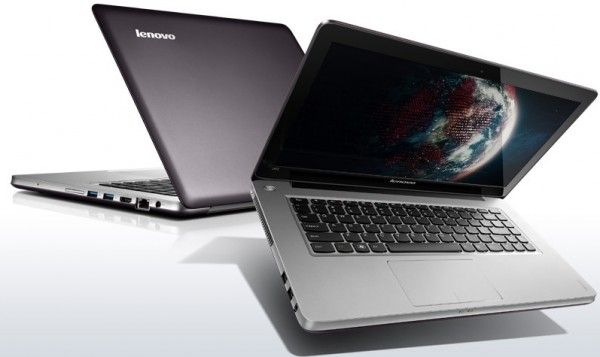This one slipped by us during IDF last week, probably because of how little attention Lenovo payed to it. Lenovo is stepping into the large end of the Ultrabook Spectrum, the 15″ class. The IdeaPad U510 Ultrabook seeks to “combine the best features of a tradition laptop with the sleek aesthetics and desirable qualities of a tablet”, according to Lenovo.
There isn’t a terrible amount of detail from Lenovo at this point regarding the IdeaPad U510. The little blurp they gave the public mention up to a Core i7 processor (almost certainly Ivy Bridge), up to 1TB of HDD storage and an “optional” 32GB SSD performance cache. Included is an optical drive, or this can be optionally upgraded to a Blu-ray drive. Unless the mention of the SSD cache being “optional” was a PR slip up, then the U510 is to be offered in non-Ultrabook form which means you’ll give up Ultrabook features like Intel Rapid Start and Smart Response in exchange for probably $100 in savings.
Lenovo says that the U510 is 21mm thick — this is borderline thickness according to Intel’s Ultrabook criteria, but it is to be expected from a larger device. Weight is quoted at a fairly hefty (for an Ultrabook) 2.2kg. The company is also claiming six hours of battery life for the U510 which doesn’t bode well compared to other Ultrabooks when we apply our 2/3 rule — expect around 4 hours of useful battery life.
The U510 is expected to be available starting this month for a modest $679. Unfortunately that low cost leads us to think we’ll be looking at a 1366×768 display on the U510 which would be less than desirable for such a large screen. Perhaps options will be available when the U510 goes up for sale — stay tuned.
The IdeaPad U510 joins other big budget Ultrabooks with optical drives like the Asus S56 and HP Envy 6 Ultrabook.
The Envy 6 starts at $799 and the Asus S56, while not yet released, is expected to start at $699 which will put it in direct competition with Lenovo’s U510. The S56 doesn’t offer an optional Blu-ray drive like the U510, but it can be optionally equipped with discrete Nvidia graphics.












“expect around 4 hours of useful battery life.”
I think this figure is too pessimistic for lot of users. Battery life should also be based on Whr, because similarly specced systems with same CPU achieve relatively close battery life.
The Macbook Air 11 inch with a 35WHr can achieve 5 hours of battery life in lot of reviews. The Zenbook 11 inch gets close as well, and for both its more true for IVB than SNB.
Of course battery life is ultimately usage dependent, but that is not predictable so we assume the most common scenario, like MP3 playback, movie watching, browsing, sometimes shown seperately.
Sure you can play the latest games, do extensive 3D rendering and video editing, but that’s pretty rarely done on battery.
If the U510 has a 50WHr battery, 6 hours is believable. It’s not exactly the smallest system anyway.
Lenovo didn’t quote a Wh (and lacked a lot of other specs too!). The 2/3 rule has treated us pretty well for years — it’s not that we’re making judgement about the battery life, we’re just cutting back the marketing claim to a more likely value. In a way it is based on Wh because we are modifying the manufacturer claim by the same amount across all systems. Most big companies are using MobileMark for battery benchmarking, probably using whatever test profile will run the computer for the longest so it ends up being a . In our experience this tends profile tends to be around 1/3 greater than typical day-to-day usage for most users.
Apple is one of the only companies that gives a reasonable battery figure — that’s why their quoted 5 hour figure lines up so nicely with reviews (and it would seem Asus was pretty honest with the UX21A as well). Don’t forget that you are comparing 11″ screens to a 15″ as well!